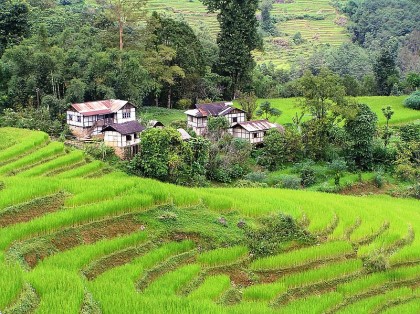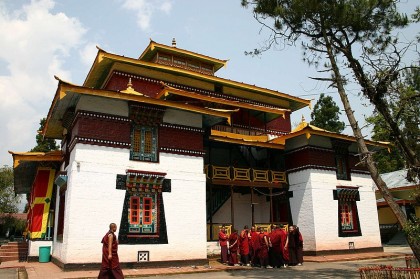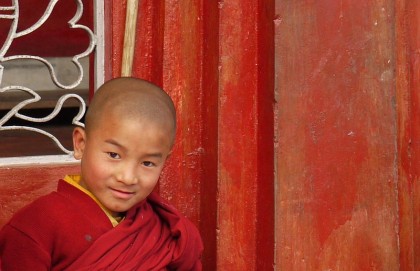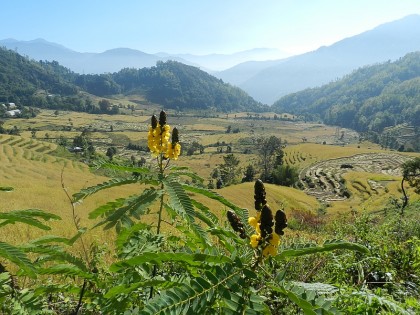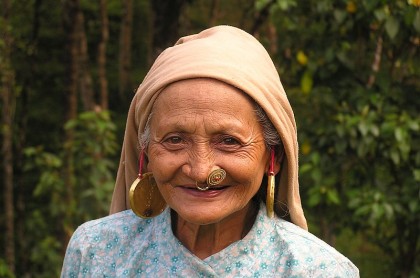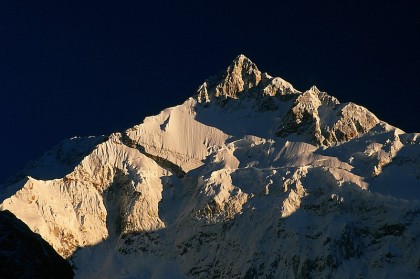
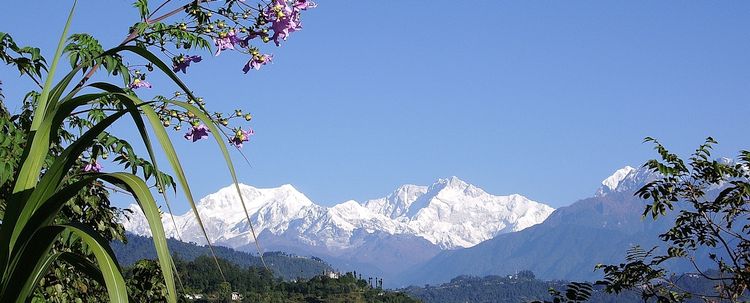
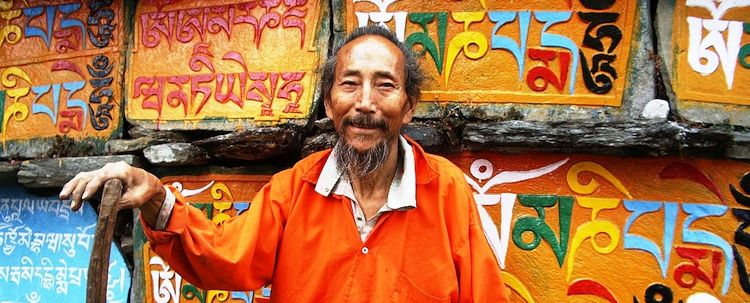
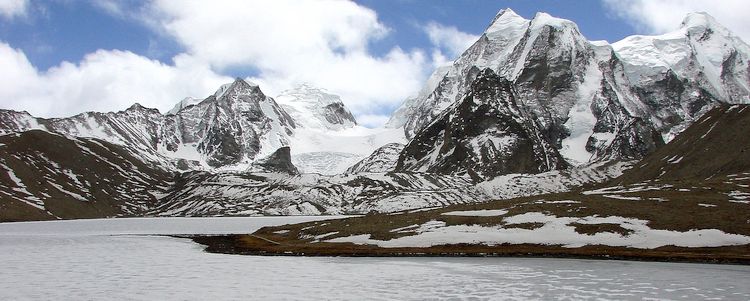
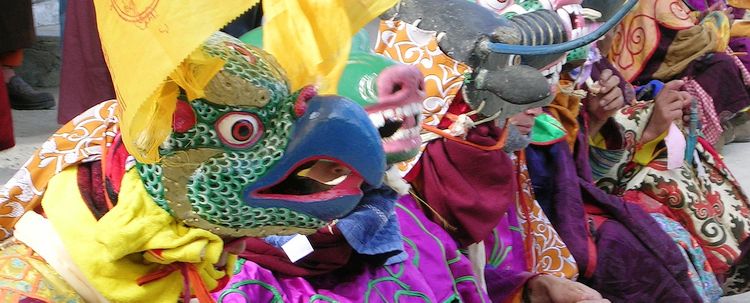
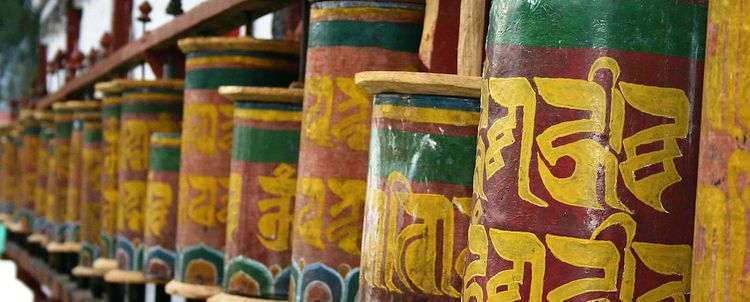
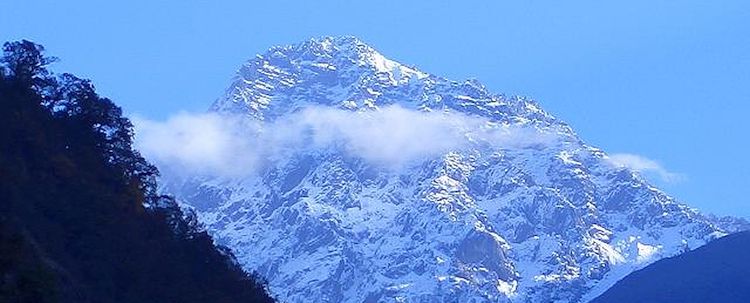
Pages Under this section
Sikkim, India – The Kingdom of the eastern Himalayas
Best Travel Time | Sikkim in Brief | Peoples and Religions | Food | Flora and fauna | National Parks and Nature Reserves | History | Economy | Mountain Scenery and trekking | Festival Calendar
As magical "Shangri-La" in the Himalayan foothills, Sikkim is nurturing forever our longing to travel. Whoever is looking for Buddhist calm and wisdom, is eager to discover the incomparable botanical diversity (Sikkim is the "biodiversity hotspot" of the world) who would like to immerse himself into the mystical atmosphere of old monasteries, has reached his dream destination in the kingdom, which was a self sufficient and independent until 1975.
The country, which is now an Indian state in the northeast of the Republic, nestled between Nepal, Tibet and Bhutan, captivates with its magnificent mountains, its Tibetan Buddhist cultural heritage, and its natural treasures. Visible everywhere are the fruits of the deep Buddhist roots, not only in the form of old monasteries (here to name exceptional are the monasteries Rumtek, Pemayangtse and Tashiding, sacred sites which are worth more than a short visit) but also in the hospitality of the people, which is truly coming from the heart. The fabulous biodiversity of flora and fauna on quite a small land area has emerged thanks to the enormous differences in altitude, and is unique in the world: in much of the country enclose subtropical forests with their colorful orchids the people, but in the north of Sikkim is Mount Kanchenjunga, with an altitude of 8585m, the third highest mountain in the world, which is sacred as a patron god to the locals.
For you as a traveler, the magical country offers a wealth of opportunities, it is a never ending source of inspiration and nourishment for all the senses. Whether you are interested in foreign cultures, in Buddhism, botany, ornithology, natural healing, tea, mountain climbing, biking or extreme sports or if you are simply looking for the experience of the Himalayas - Sikkim will cast a spell on you forever. Since a few years only, the Indian government promotes tourism in Sikkim, and does it in an astonishingly sustainable, environmentally and humanely optimized manner, it appears as one of the first governments in the world to have recognized and implemented the importance of preserving the original setting for a long-term success.
If you are interested in a vacation in Sikkim, simply rely on our in-depth experience and competence for the organization, and concentrate without any worries on the experience of the Himalayas, on the unique clarity of the mountains, the exuberant variety of subtropical nature, and thus completely on the distinctive small everyday things that make out the living Buddhism. Your experiences will additionnally strengthen the bridge between cultures built by us.
Best Travel Time for Sikkim
Spring - March to early June
Spring is the best time to experience the variety of flowers in Sikkim. Dense forests, colorful due to blooming rhododendron and magnolia trees, adorn the mountainsides and bewitch with their sweet scent. Primroses, orchids and bougainvillea have high season. The rural population is engaged in the sowing and grazing.
Summer - mid-June to September
The monsoon brings Sikkim heavy rainfall and high humidity at temperatures of 20 to 30 ° C. The terraced rice fields are filled with water and rice is producing roots. The north is more likely be spared by the monsoon, and now produces its colorful alpine flora.
Autumn - October to mid-December
This is the best hiking time: The monsoon is over, the valleys are green, the sky a deep blue. The mountain view is clear and the sun is shining most of the time. Autumn is harvest time, and there are many colorful festivals on religious occasions taking place.
Winter - December to March
Mild temperatures and clear skies are ideal conditions for hiking in lower altitudes. Now the New Year of Sikkim and Tibet are celebrated; religious dances and archery are being performed.
Sikkim in Brief
| Location | In the northeast of India on the southern slopes of the Himalayas. Borders Nepal in the west, Tibet to the north and northeast, Bhutan in the southeast and the Indian state of West Bengal in the south. |
| Area | 7096 km² |
| Population | 607.688 (2011)/approx. 86 per km² |
| Capital | Gangtok |
| Districts | 4: North, East, South and West |
| Topography | Sikkim is situated in the Himalayas, with differences in height of more than 8200 m. In the south the Teesta valley extends down to 300 meters, while the land in the northwest rises to 8598 m (Mt. Kanchenjunga) |
| Vegetation | More than 4,000 different plant species, including 450 species of orchids, 300 species of ferns, and more than 40 kinds of Rhododendron. |
| Wildlife | 144 mammals, among them the snow leopard, red panda, black bear, jungle cat, jackal and musk deer; more than 450 species of birds, more than 400 species of butterflies .. |
| Climate | Tropical, subtropical, temperate and alpine regions. Monsoon rains during the summer. The snow line is at about 5000 m, the tree line at 3700 m. |
| Temperatures | Average values at 1500 m above sea level. From April to September between 18 ° C and 30 ° C, from October to March between 3 ° C and 18 ° C. The lowest temperatures are reached in December and January. |
| Rainfall | In the area around Gangtok fall about 325 cm of precipitation per year. In Nordsikkim It is only 60 cm. The wettest month is July. |
| Languages | Nepali, Bhotia, Lepcha, Limbu, Tibetian, English, Hindi, Bengali. |
| Ethnicities | Nepalis (about 80%), Lepchas and Bhotias (about 20%). Furthermore Indians and Tibetans. |
| Religions | Buddhism (approximately 29%), Hinduism (62%), Shamanism, Christianity (about 7%). Further Muslims (1.4%), Sikhs and Jains. |
| Economy | The economy of Sikkim is mainly based on agriculture: there corn, rice, wheat, barley, buckwheat, millet, cardamom, tea, tangerines and apples are being cultivated and livestock is being bred. In the south of the country there is a little processing industry: distilleries, breweries, tanneries and factories, in which watches are produced are located here. Tourism is also developing to become a mainstay of the economy, thanks to the promotion through the government. |
| Getting there | Flight to Kolkata or Delhi in India. From there by air (Jet Airways, Indian Airlines, Air Deccan) to Bagdogra or from Delhi (about 21 hours) or Kolkata by train to NJP (New Jalpaiguri). From airport Bagdogra by jeep to Sikkim (130 km, about 5 hours) or from the railway station NJP by jeep to Sikkim (124 km, about 4.5 hours). |
| Visa / Entry permit | A visa is required for the entry to India. In addition a separate entry permit for Sikkim, which is stamped by the Embassy of India for 15 days on the visa. For stays of more than 15 days, an extension for up to 60 days may be requested. Further approvals are needed for trekking and visiting North Sikkim, Tsomgo lake and other protected regions, which we will organize. |
| Vaccinations | In addition to the standard vaccinations, immunizations against hepatitis, typhoid, rabies, meningococcal meningitis and Japanese encephalitis are recommended. |
Peoples and Religions
As colorful as the country, as open and warm-hearted are the people of Sikkim. Sikkim is still sparsely populated today, especially in the north, with around 610,000 inhabitants, about 75% of the people live in rural areas. The indigenous people here are the Lepchas. In their language they call themselves "Muntanchi": the most loving people of Mother Earth. The Bhotias, which immigrated from the 9th century onwards from Tibet, are considered the second oldest ethnic group in Sikkim. They brought the Tibetan Mahayana Buddhism into the country, and joined the Lepchas in a peaceful, stable brotherhood. Since the beginning of the 19th century many Nepalis immigrated to Sikkim, and they brought among other, knowledge about the rice and cardamom cultivation with them, and they represent today's largest population with over 75%.
The diverse ethnic composition of the population brings an equal religious diversity with it. Rather hidden is the shamanism of the Lepchas taking place, which has aroused the curiosity of Western researchers already several years ago. Many "new" findings of our conventional medicine are based on the ancient knowledge of the healing power of plants, with which the shamans have always healed and protected their people. Even until today Sikkim retained its deep roots in Tibetan Buddhism, although the now most commonly practiced religion is Hinduism, which the Nepalese immigrants have brought into the country. The Mahayana Buddhism has nevertheless been the state religion for a long time - today a tribute to the tribes of the indigenous people.
Numerous large and very old and to the present day animate monasteries adorn the mountains, and are popular attractions for the few Western visitors and sites of rest, but for the faithful they are partly sacred places of pilgrimage. Also, they are the venue of traditional rites and festivals again and again. The mysticism of the old walls, monks wrapped in red, fluttering prayer flags and rotating prayer wheels characterize the image of the country for visitors.
Food
On the terraced fields of Sikkim mainly rice, corn, potatoes and millet are being cultivated in the simplest manner, only by hand or with the support of wooden plows, which are drawn by oxen. Furthermore, plantations of different varieties of teas and spices can be found. The tangerines, apples, papaya and bananas, fruits which are growing in the subtropical regions, contribute to the fruit diversity of Sikkim; black cardamom, tea, tangerine and ginger are among the main export commodities. Rice and dhal, the soup of legumes, is the staple food of the population. In addition, Tibetan (rice) noodle dishes, meat pouches (momos) and the more extensive Indian and Chinese cuisine is now prevalent everywhere. A distinctive feature of the cuisine of Sikkim are historical and extremely tasty dishes made of nettles, fermented leafy vegetables and lilies that you should by no means miss while traveling around Sikkim.
Flora and fauna
Sikkim is a botanical wonderland, whose geographical range is spreading from permanently snowcapped mountain landscapes over mountain lakes, rivers and natural thermal springs up into subtropical lowlands, and which has produced an exuberant diversity of plants. More than 500 species of trees form the mixed and coniferous forests of the subtropical and the temperate zones, complemented by bamboo, which also grows tree high here, and ferns that cover the floors of the forests. Depending on the season whole mountainsides are glowing from the flowers of magnolias and rhododendrons or the radiant individual flowers of highly colored orchids are visible through the greenery.
More than 500 species of orchids Cymbidiums, Vandas, Cattlelyas, Dendrobiums, Hooheriana, Farmeri and so on are growing here, but also different kinds of arum lily, azaleas and more than 60 kinds of primrose, some of which have their origin here. Not only the visitors especially interested in botany will be fascinated by the unique, bright blue colour with which so many a flower, such as the poppy Meconopsis or the blue fumewort, Corydalis cashmeriana adorns itself. Equally fascinating is the insight into the mode of action of more than 600 known medicinal plants, of which an increasing number of extracts and active ingredients find their way into our Western medicine.
The diversity of animal species in Sikkim is as great as that of the plants and the landscapes. Situated in the slightly higher locations, and for Western Europeans extremely fascinating to discover is the snow leopard. In these heights you can find - and hear! - also a variety of sheep and goat species, although sometimes as a part of a domesticated herd; also yaks are grazed by the Sherpas. The red panda, jungle cats the black bear and the jackal are among the larger mammals, which are located in the lower elevations and the forests. In addition, the eyes and ears rejoice here about approximately 500 species of birds, whose names let partially already guess their fairytale beauty: the Chinese nightingales, orange- headed thrush, sunbirds, red-vented bulbul, silver-eared leiothrix, goosander, darters, and many, many more inhabit highlands, forests and lakes. In the subtropical lowlands, moreover even the fluttering colorful dabs of more than 400 different species of butterflies enrich the life and variety of colors additionally.
National Parks and Nature Reserves
Since the population of Sikkim, despite the Nepalese immigration in the 19th century and the then suddenly increasing agricultural use of land area, never lost respect for Mother Nature, and accessed her treasures carefully, it has never been necessary to put certain areas under any special protection. And so there is to the present day only one large, official National Park in the territory of the State of Sikkim: the Khangchendzönga National Park with a protected area of 850 square kilometers, around the holy mountain Khangchendzonga, from which it got the name.
Many pilgrimage routes lead to here, and to see the impressive, third highest peak in the world is certainly one of the most outstanding experiences on a Sikkim tour. In addition, certain areas in the north are reserved for the use and even the entrance of the indigenous people living here, which also preserves flora and fauna in their natural, original variety. Foreigners are only permitted after obtaining special permits to travel these areas – however for true nature enthusiasts, this represents an unique and with certainty an unforgettable experience. A variety of small nature reserves statewide protects certain populations and biodiversity hotspots.
History
As the first established inhabitants of today‘s Sikkim must be seen the Lepcha people, which are proven to already have settled here in the 8th century AD. Gradually then poured in in waves, which have often been caused by wars or diseases in the homeland, more and more of the Bhotia people from eastern Tibet into the country. The two peoples lived in Buddhist faith and installed quickly a peaceful coexistence, a covenant of blood brotherhood which is ruled by a monarchy since 1642. Since the 13th century already, Sikkim repeatedly saw encroachments of foreign powers which wanted some important passes through the Himalayas, which are to be crossed otherwise only with difficulty, to be counted among the territories of their own.
Were these until the end of the 18th century mainly neighboring nations, such as Nepal and Tibet, now conquered with the British a much stronger party surrounding areas, and called the equally exceedingly powerful neighbor to the north to be more vigilant, China. With its own independence from the British Empire in 1947, India then wanted to strengthen her position of power above all other. 1953 Sikkim was placed under Indian administration, in 1975 then added as a 22nd state of the Indian Republic. This, although purely political, in its correct execution however, extremely controversial and from e.g. China up to 2003 unaccepted acquisition is the last major change of power, which the people of Sikkim had to accept. The opening of the Nathu La - pass over the Himalayas in 2006 meant the first opening of the border between India and China and has marked the beginning of a continuous further opening up to today, also for Western travelers.
Economy
The mainstay of the economy of Sikkim is even today the agriculture in the south of the state. On the terraced hillsides, the fields are being planted with rice and tea, where possible with the help from teams of oxen, but usually like in times of yore, in seemingly tedious, strenuous work by hand. People use the shadows of the woods for the growing of mandarins, cardamom and ginger, even small plantations of orange and apple trees enchant the air with their fragrance.
Also the cultivation of orchids and other garden plants represents a not insignificant economic sector, as well as the broader forest management. Industrialized, advanced processing is found almost exclusively in the form of tanneries, distilleries and breweries, as well as manufacturing facilities for watches near the towns of Melli and Jorathang in the south. In addition, raw materials are sourced in Sikkim in small quantities, these include graphite, copper, iron, mica (an aluminosilicate for optical applications and insulating materials), coal, limestone and dolomite.
Since several years, the Indian government aims to promote the potential of tourism in Sikkim and to expand this systematically. So far, this is being done in a praiseworthy, gentle and deliberately sustainable way: nature is retained, the people are being integrated and as cultural bridge-builders we support this process willingly! An example of the sustainability of the economic development is certainly also that the increasing demand for electricity is met primarily by hydroelectric power plants, of which some are under construction, and will not only stabilize the domestic power grid in the near future, but produce current also to let it become another export commodity.

